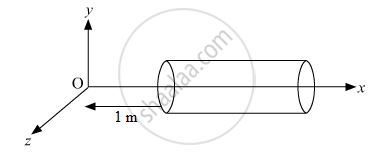Advertisements
Advertisements
प्रश्न
A hollow cylindrical box of length 1 m and area of cross-section 25 cm2 is placed in a three dimensional coordinate system as shown in the figure. The electric field in the region is given by `vecE = 50xhati` where E is NC−1 and x is in metres. Find
(i) Net flux through the cylinder.
(ii) Charge enclosed by the cylinder.

उत्तर

Given,`vecE = 50xhati and Δs = 25 cm^2 = 25 xx 10^-4 m^2`
As the electric field is only along the x-axis, so, flux will pass only through the cross-section of cylinder.
magnitude of electric field at cross - section A,`E_A = 50 xx 1 =50N C^-1`
magnitude of electric field at cross - section `B,E^B = 50 xx 2 = 100 N C^-1`
The corresponding electric fluxes are :
`ø_A = vecE.Δvecs = 50 xx 25 xx 10^-4 xx cos 180° = -0.125 N m^2 C^-1`
`ø_A = vecE.Δvecs = 100 xx 25 xx 10^-4 xx cos 0° = 0.25N m^2 C^-1`
So, the net flux through the cylinder,`ø =ø_A +ø_B = -0.125 + 0.25 = 0 . 125 N m^2C^-1 `
(ii) Using Gauss’s law: `ointvecE.dvecs =q/in_0⇒ 0.125 = q/(8.85 xx 10^-12)⇒ q=8.85 xx 0.125 xx 10^-12 =1.1 xx 10 ^-12 C `
संबंधित प्रश्न
Consider a system of n charges q1, q2, ... qn with position vectors `vecr_1,vecr_2,vecr_3,...... vecr_n`relative to some origin 'O'. Deduce the expression for the net electric field`vec E` at a point P with position vector `vecr_p,`due to this system of charges.
Why does a phonograph record attract dust particles just after it is cleaned?
A point charge q is rotated along a circle in an electric field generated by another point charge Q. The work done by the electric field on the rotating charge in one complete revolution is
A 10-cm long rod carries a charge of +50 μC distributed uniformly along its length. Find the magnitude of the electric field at a point 10 cm from both ends of the rod.
An electric field of 20 NC−1 exists along the x-axis in space. Calculate the potential difference VB − VA where the points A and B are
(a) A = (0, 0); B = (4 m, 2m)
(b) A = (4 m, 2 m); B = (6 m, 5 m)
(c) A = (0, 0); B = (6 m, 5 m)
Do you find any relation between the answers of parts (a), (b) and (c)?
An electric field \[\vec{E} = ( \vec{i} 20 + \vec{j} 30) {NC}^{- 1}\] exists in space. If the potential at the origin is taken to be zero, find the potential at (2 m, 2 m).
Find the magnitude of the electric field at the point P in the configuration shown in the figure for d >> a.
Two similar spheres having +Q and -Q charges are kept at a certain distance. F force acts between the two. If at the middle of two spheres, another similar sphere having +Q charge is kept, then it experiences a force in magnitude and direction as ______.
